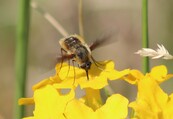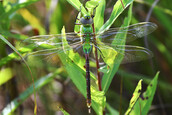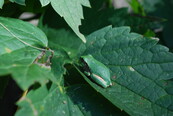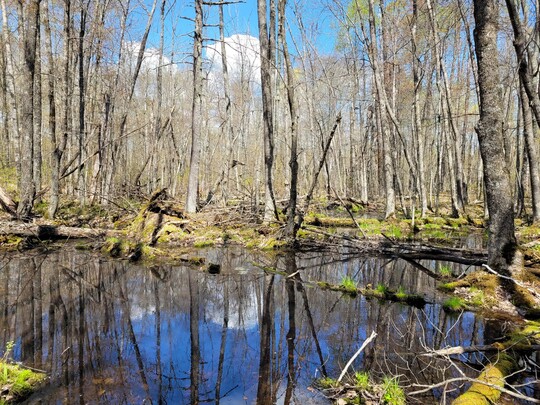|
May, 2023
Sunny days, songbirds, frog and toad calls, turtles sunbathing, nesting season…there’s a lot to look forward to this spring!
Thousands of songbirds are flying back to Minnesota to begin courting and start their nesting season. You can find these species in your backyard and neighborhood, but if you’d like to travel, we have some Minnesota Scientific and Natural Areas (SNA) and state parks to recommend to get your birding fix this spring.
Avon Hills Forest SNA
A yellow warbler, photo by USFWS
With over 350 acres to explore, Avon Hills Forest SNA is a great place to find spring migrants. There are no maintained trails at this site, but notable birds here include the cerulean warbler, yellow warbler (pictured), blue-winged warbler and red-shouldered hawk. Be sure to print or download their birding checklist before you go!
Carley State Park
Vibrant bluebell flowers
Carley State Park is known for its spring bluebells (pictured), but this park is a good birding spot as well! The park is home to warblers, vireos, flycatchers, thrushes and more during the spring and summer. Park staff have also seen bald eagles swooping down by the Whitewater River, which runs through the park.
Flandrau State Park
A monarch butterfly resting on yellow flowers
Flandrau State Park is located along the Cottonwood River. The park’s woodland forest and wetlands provide excellent habitat for migrating and nesting birds. Warblers, vireos, thrushes, wild turkeys and wood ducks have all been observed at the park. The wildflowers in the park are also attractive to pollinators like the monarch butterfly (pictured).
Itasca Wilderness Sanctuary SNA
A cedar waxwing
If you’re visiting the Mississippi River headwaters, make sure to stop at Itasca Wilderness Sanctuary SNA! This site was established in 1939 within Itasca State Park, and became an SNA in 1983. Follow the Bohall Lake trail through old growth forest. Along your way, you may spot trumpeter swans, cedar waxwings (pictured), black-backed woodpeckers and other bird species.
Lake Bemidji State Park
Wild asters in Lake Bemidji State Park
What better way to celebrate Lake Bemidji State Park's 100th anniversary than with a birding trip? Walk along Paul Bunyan State Trail to see wild asters (pictured) and hear loons, grebes, swans, warblers and more! And don’t worry about bringing binoculars, the park has birding kits you can check out for free.
Mille Lacs Moraine SNA
A hairy woodpecker
With mature deciduous forests and wetlands, Mille Lacs Moraine SNA is a unique landscape that offers critical breeding habitat for red-shouldered hawks, purple martins and cerulean warblers. You can also get a glimpse of hairy woodpeckers (pictured), barred owls, winter wrens among other species. There are no maintained trails at this site.

One sure sign of spring is the return of buzzing flies. While some species can certainly be annoying, there are many species of flies, like the bee fly (pictured), that play a key role in our global food supply. They are second only to bees in the number of crops they pollinate!
Prairie flies are also key members of the prairie community, pollinating flowers as they feed on nectar. So when you start to notice flies buzzing about, remember that they’re another great example of the surprising diversity and beauty in our prairies.
|

Birds aren’t the only species that will be making their way back north! Monarch butterflies and some dragonfly species will also be arriving back in Minnesota this spring. Use Journey North’s interactive map to track the great monarch migration and consider planting a pollinator friendly garden in your backyard or on your balcony to attract these pollinators to your area.
(Photo by USFWS)
|
|
Like many species, toads and frogs begin searching for a mate in spring. They’ll gather around water edges and males will announce their presence with “advertisement calls”. Some species, like wood frogs are “explosive breeders”, gathering in large numbers for only a few days. Others, like treefrogs (pictured), are “prolonged breeders”, which can be heard calling over several weeks.
Learn more about this frog and toad opera over on our website.
|
|
 |
 Explore the magic of seasonal spring ponds with Larry Weber’s article “Spring-to-life Ponds.”
Birds of Minnesota State Parks is also an excellent tool with bird checklists for Minnesota State Parks. Written by noted ornithologist Robert B. Janssen and published by MNDNR Nongame Wildlife Program, and funded by the Clean Water Legacy Fund, this book will provide you and your family and friends with another great reason to visit Minnesota state parks! It can be purchased at the University of Minnesota bookstore or look for it at your local library.
|